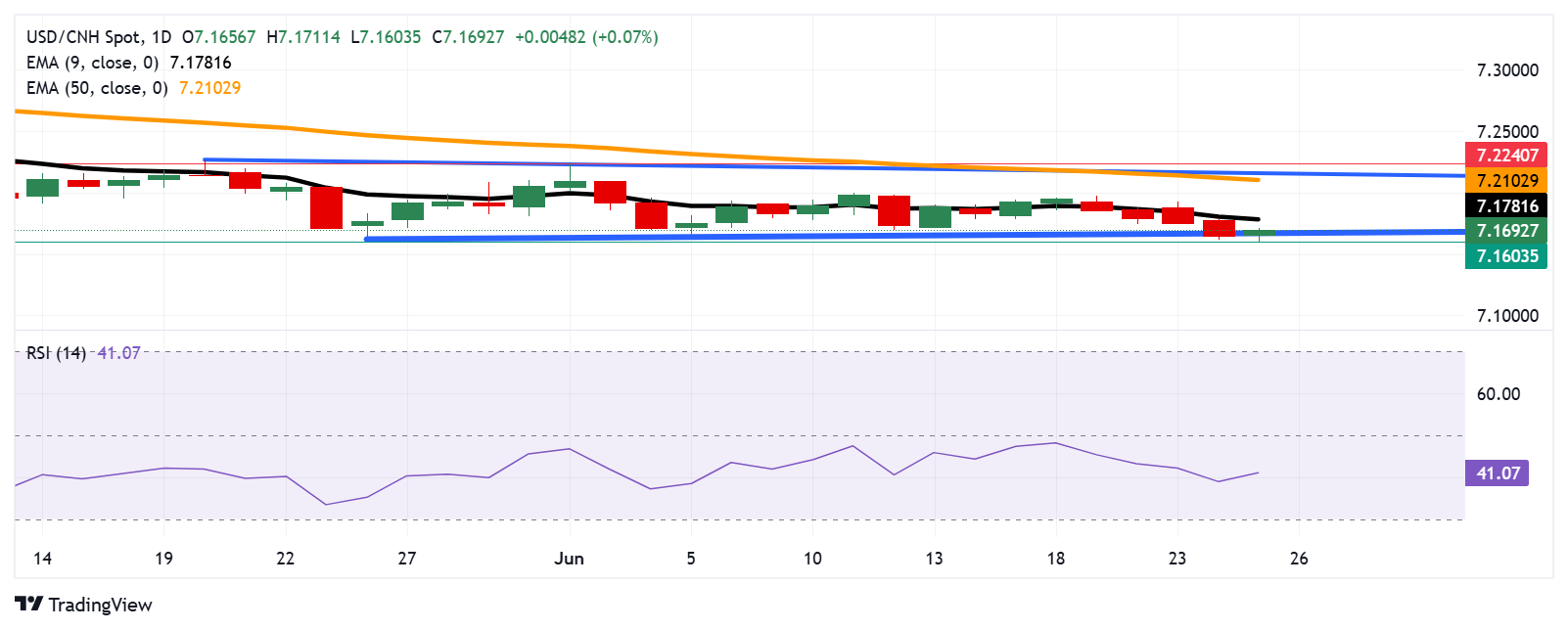USD/CNH Price Analysis: Hovers around 7.1700 near rectangle’s lower boundary
- USD/CNH tests the immediate support at the lower boundary of the rectangle around 168.80.
- The 14-day Relative Strength Index remains below the 50 level, indicating a prevailing bearish bias.
- The primary support appears at the nine-day EMA at 7.1781.
The USD/CNH pair halts its four-day winning streak, trading around 7.1690 during the Asian hours on Wednesday. An analysis of the daily chart indicates that the pair moves sideways within a rectangular pattern, which points to a consolidation phase.
However, the 14-day Relative Strength Index (RSI), a key momentum indicator, remains below the 50 level, suggesting a bearish momentum is in play. Additionally, the USD/CNH pair trades below the nine-day Exponential Moving Average (EMA), further suggesting weaker short-term price momentum.
On the downside, the USD/CNH pair hovers around the lower boundary of the rectangle around 168.80. A break below this level could confirm the ongoing bearish bias and put the downward pressure on the pair to retest the seven-month low at 7.1603, which was recorded on June 25.
The nine-day EMA at 7.1781 appears as the initial barrier. A successful breach above this level would improve the short-term price momentum and support the pair to explore the region around the 50-day EMA at 7.2102, followed by the rectangle’s upper boundary around 7.2150. Further resistance appears at the monthly high of 7.2240, reached on June 2.
USD/CNH: Daily Chart

Central banks FAQs
Central Banks have a key mandate which is making sure that there is price stability in a country or region. Economies are constantly facing inflation or deflation when prices for certain goods and services are fluctuating. Constant rising prices for the same goods means inflation, constant lowered prices for the same goods means deflation. It is the task of the central bank to keep the demand in line by tweaking its policy rate. For the biggest central banks like the US Federal Reserve (Fed), the European Central Bank (ECB) or the Bank of England (BoE), the mandate is to keep inflation close to 2%.
A central bank has one important tool at its disposal to get inflation higher or lower, and that is by tweaking its benchmark policy rate, commonly known as interest rate. On pre-communicated moments, the central bank will issue a statement with its policy rate and provide additional reasoning on why it is either remaining or changing (cutting or hiking) it. Local banks will adjust their savings and lending rates accordingly, which in turn will make it either harder or easier for people to earn on their savings or for companies to take out loans and make investments in their businesses. When the central bank hikes interest rates substantially, this is called monetary tightening. When it is cutting its benchmark rate, it is called monetary easing.
A central bank is often politically independent. Members of the central bank policy board are passing through a series of panels and hearings before being appointed to a policy board seat. Each member in that board often has a certain conviction on how the central bank should control inflation and the subsequent monetary policy. Members that want a very loose monetary policy, with low rates and cheap lending, to boost the economy substantially while being content to see inflation slightly above 2%, are called ‘doves’. Members that rather want to see higher rates to reward savings and want to keep a lit on inflation at all time are called ‘hawks’ and will not rest until inflation is at or just below 2%.
Normally, there is a chairman or president who leads each meeting, needs to create a consensus between the hawks or doves and has his or her final say when it would come down to a vote split to avoid a 50-50 tie on whether the current policy should be adjusted. The chairman will deliver speeches which often can be followed live, where the current monetary stance and outlook is being communicated. A central bank will try to push forward its monetary policy without triggering violent swings in rates, equities, or its currency. All members of the central bank will channel their stance toward the markets in advance of a policy meeting event. A few days before a policy meeting takes place until the new policy has been communicated, members are forbidden to talk publicly. This is called the blackout period.
